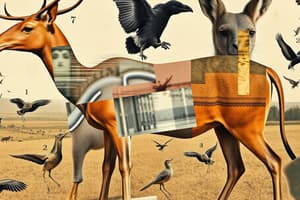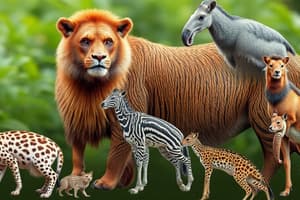Podcast
Questions and Answers
Which phylum in the animal kingdom is characterized by animals with true tissues and asymmetrical body structures?
Which phylum in the animal kingdom is characterized by animals with true tissues and asymmetrical body structures?
- Porifera (correct)
- Echinodermata
- Cnidaria
- Platyhelminthes
What feature distinguishes mollusks from other phyla in the animal kingdom?
What feature distinguishes mollusks from other phyla in the animal kingdom?
- They are segmented organisms.
- They possess stinging cells.
- They are exclusively terrestrial.
- They typically have a hard shell. (correct)
Which of the following correctly describes the body structure of organisms in the phylum Nematoda?
Which of the following correctly describes the body structure of organisms in the phylum Nematoda?
- Pseudocoelomates with bilateral symmetry. (correct)
- Acoelomates with radial symmetry.
- Soft-bodied without any formal structure.
- Coelomates with segmented bodies.
What key characteristics are associated with the phylum Chordata?
What key characteristics are associated with the phylum Chordata?
In which phylum do animals have jointed limbs and are characterized by an exoskeleton made of chitin?
In which phylum do animals have jointed limbs and are characterized by an exoskeleton made of chitin?
What distinguishes the Cnidaria phylum from other animal phyla?
What distinguishes the Cnidaria phylum from other animal phyla?
Which of the following describes the body structure of organisms in the phylum Annelida?
Which of the following describes the body structure of organisms in the phylum Annelida?
Which statement best describes invertebrates in the animal kingdom?
Which statement best describes invertebrates in the animal kingdom?
Which body form is NOT associated with Cnidaria?
Which body form is NOT associated with Cnidaria?
Which subphylum of Chordata includes organisms without a backbone?
Which subphylum of Chordata includes organisms without a backbone?
Flashcards
What is the largest phylum in the animal kingdom?
What is the largest phylum in the animal kingdom?
The largest animal phylum is Arthropoda, which includes insects, spiders, crustaceans, and others. It's characterized by having an exoskeleton, segmented bodies, and jointed limbs.
What are the key characteristics of chordates?
What are the key characteristics of chordates?
Chordates are animals with a notochord, a dorsal nerve cord, pharyngeal slits, and a post-anal tail at some point in their development. These features define them as a distinct group.
What is the difference between invertebrates and vertebrates?
What is the difference between invertebrates and vertebrates?
Invertebrates are animals without a backbone, such as insects, worms, and sponges. Vertebrates have a backbone, which includes animals like fish, birds, and mammals.
What is a coelom?
What is a coelom?
Signup and view all the flashcards
What are the two body forms of cnidarians?
What are the two body forms of cnidarians?
Signup and view all the flashcards
What is a notochord?
What is a notochord?
Signup and view all the flashcards
What are pharyngeal slits?
What are pharyngeal slits?
Signup and view all the flashcards
How are animals classified?
How are animals classified?
Signup and view all the flashcards
What is the difference between a coelomate and an acoelomate?
What is the difference between a coelomate and an acoelomate?
Signup and view all the flashcards
What are the characteristics of Porifera?
What are the characteristics of Porifera?
Signup and view all the flashcards
Study Notes
Animal Kingdom
Classification of Animals
- Animals are classified based on:
- Body structure
- Level of organization
- Mode of reproduction
- Habitat
Major Phyla in Animal Kingdom
-
Porifera
- Simple body structure (sponges)
- Asymmetrical, no true tissues
- Aquatic, mostly marine
-
Cnidaria
- Radially symmetrical (jellyfish, corals)
- Possess stinging cells (cnidocytes)
- Two body forms: polyp and medusa
-
Platyhelminthes
- Bilateral symmetry (flatworms)
- Acoelomates (no body cavity)
- Can be free-living or parasitic
-
Nematoda
- Roundworms, bilateral symmetry
- Pseudocoelomates (body cavity present but not entirely lined by mesoderm)
- Diverse habitats, many are parasitic
-
Annelida
- Segmented worms (earthworms, leeches)
- True coelomates (body cavity fully lined by mesoderm)
- Have a segmented body plan
-
Arthropoda
- Largest phylum (insects, arachnids, crustaceans)
- Exoskeleton made of chitin
- Jointed limbs and segmented bodies
-
Mollusca
- Soft-bodied animals (snails, octopuses)
- Usually have a hard shell
- Body divided into head, foot, and visceral mass
-
Echinodermata
- Marine animals (starfish, sea urchins)
- Radial symmetry in adults, bilateral in larvae
- Endoskeleton made of calcified plates
-
Chordata
- Animals with a notochord (vertebrates and some invertebrates)
- Key features: dorsal nerve cord, pharyngeal slits, post-anal tail
- Divided into subphyla: Urochordata, Cephalochordata, Vertebrata
Characteristics of Chordates
- Subphyla:
- Urochordata: Tunicates, marine, filter feeders.
- Cephalochordata: Lancelets, small, aquatic, filter feeders.
- Vertebrata: Animals with a backbone, includes fish, amphibians, reptiles, birds, mammals.
Invertebrate vs. Vertebrate
- Invertebrates: Animals without a backbone (e.g., sponges, cnidarians, arthropods).
- Vertebrates: Animals with a backbone (e.g., fish, birds, mammals).
Key Concepts
- Animals are categorized into invertebrates and vertebrates.
- The classification reflects evolutionary relationships.
- Habitat and mode of reproduction influence animal diversity and adaptation.
- The Animal Kingdom exhibits a wide range of structures and functions adapted to various environments.
Classification of Animals
- Animals are grouped based on body structure, organization level, reproductive mode, and habitat.
Major Phyla in Animal Kingdom
-
Porifera
- Comprises sponges; characterized by a simple body structure.
- Lacks true tissues and exhibits asymmetry.
- Predominantly aquatic, mostly in marine environments.
-
Cnidaria
- Includes jellyfish and corals; exhibits radial symmetry.
- Features specialized stinging cells known as cnidocytes.
- Comes in two forms: polyp (sessile) and medusa (free-floating).
-
Platyhelminthes
- Known as flatworms; has bilateral symmetry.
- Lacks a body cavity (acoelomate).
- Can be found as free-living organisms or parasites.
-
Nematoda
- Roundworms featuring bilateral symmetry.
- Classified as pseudocoelomates with a body cavity not completely lined by mesoderm.
- Occupies a variety of habitats, with many species being parasitic.
-
Annelida
- Comprised of segmented worms like earthworms and leeches.
- True coelomates with a body cavity that is entirely lined by mesoderm.
- Features a distinct segmented body plan.
-
Arthropoda
- The largest phylum, including insects, arachnids, and crustaceans.
- Possesses an exoskeleton made from chitin.
- Characterized by jointed limbs and segmented bodies.
-
Mollusca
- Soft-bodied animals such as snails and octopuses; often have a hard shell.
- Body structure is divided into three parts: head, foot, and visceral mass.
-
Echinodermata
- Marine organisms such as starfish and sea urchins.
- Exhibit radial symmetry as adults and bilateral symmetry as larvae.
- Possess an endoskeleton formed of calcified plates.
-
Chordata
- Defined by the presence of a notochord; includes vertebrates and some invertebrates.
- Key traits include a dorsal nerve cord, pharyngeal slits, and a post-anal tail.
- Divided into subphyla: Urochordata (tunicates), Cephalochordata (lancelets), and Vertebrata (animals with backbones).
Characteristics of Chordates
- Urochordata: Tunicates, marine creatures known for filter feeding.
- Cephalochordata: Lancelets, small aquatic organisms also filter feeders.
- Vertebrata: Backbone-containing animals, encompassing fish, amphibians, reptiles, birds, and mammals.
Invertebrate vs. Vertebrate
- Invertebrates are animals lacking a backbone, including sponges, cnidarians, and arthropods.
- Vertebrates possess a backbone, represented by species such as fish, birds, and mammals.
Key Concepts
- Animals are categorized into invertebrates and vertebrates, highlighting evolutionary relationships.
- Identification and classification are influenced by habitat preference and reproductive strategies.
- The Animal Kingdom is diverse in structure and function, with adaptations suited to a range of environments.
Studying That Suits You
Use AI to generate personalized quizzes and flashcards to suit your learning preferences.




